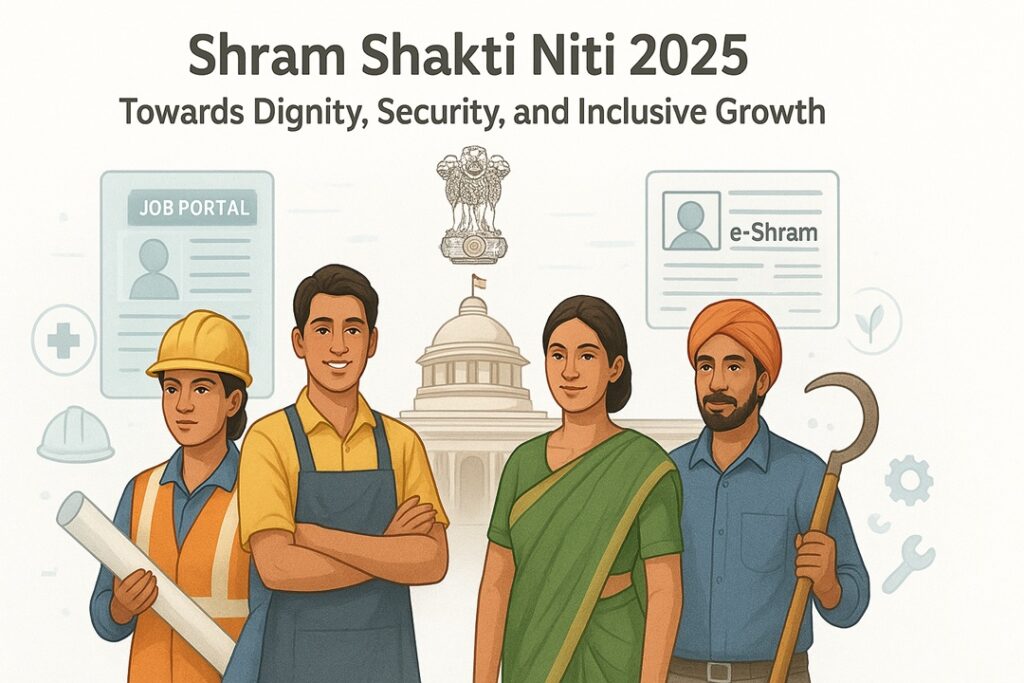Shram Shakti Niti 2025: Promise and Challenges in India’s Labour Reforms

Context
The ongoing debate on the draft Shram Shakti Niti 2025 has drawn national attention to India’s fragile labour ecosystem. The policy, projected as a “future-ready” framework, aims to modernise employment and ensure dignity for workers. However, critics argue that it overlooks systemic rights violations, weak enforcement, and the persistent vulnerability of informal workers who constitute the majority of India’s labour force.
Understanding Labour Exploitation
- Refers to coercive or unfair treatment of workers who are denied fair wages, safe conditions, and legal rights.
- Involves forced labour, long working hours, or manipulative contracts that trap workers in dependency or debt.
- Violates the principles of dignity, equality, and justice enshrined in labour and human rights laws.
Modern Slavery in India
- India has over 11 million forced labourers, the highest globally.
- Reflects deep-rooted vulnerability among workers lacking legal and contractual protection.
Dominance of the Informal Workforce
- Nearly 90 percent of India’s labour force works in the informal sector.
- Excluded from provident fund, health insurance, and pension schemes.
- Exposes the fragility of India’s social protection and labour welfare systems.
Constitutional and Legal Violations
- Reclassification of employees as “daily wagers” enables wage theft and denial of benefits.
- Violates Articles 14, 16, and 23 of the Constitution ensuring equality, equal opportunity, and prohibition of forced labour.
Decline of Trade Unions
- Dependence on contract and casual labour has weakened collective bargaining.
- Erosion of union strength reduces workers’ ability to negotiate fair conditions.
International Commitments and Compliance
- India’s weak adherence to ILO Conventions 29 (Forced Labour) and 155 (Occupational Safety) undermines global credibility.
- Reflects inadequate enforcement and monitoring of international labour standards.
Key Features of Shram Shakti Niti 2025
- Envisions a dignified and inclusive world of work with universal social security, gender empowerment, and sustainable jobs.
- Proposes a Universal Social Security Account integrating EPFO, ESIC, PM-JAY, and e-Shram for lifelong and portable protection.
- Transforms the National Career Service into an AI-driven Employment Digital Public Infrastructure for transparent job matching.
- Targets 35 percent female workforce participation by 2030 through flexible work models, childcare, and vocational training.
- Introduces a single-window digital compliance portal for self-certification and trust-based governance.
- Creates a Labour and Employment Stack integrating worker identities, enterprise databases, and entitlements.
- Establishes National, State, and District Labour Missions with a Labour and Employment Policy Evaluation Index for tracking progress.
Gaps in Shram Shakti Niti 2025
- No clarity on funding sources for Universal Social Security, risking unsustainable implementation.
- Dependence on digital platforms may exclude women, elderly, and rural low-literacy workers.
- Weak inspection systems make the goal of “zero workplace fatalities by 2047” unrealistic.
- Gender targets lack childcare facilities, maternity benefits, and safety measures.
- Use of AI for job matching without ethical oversight risks caste, regional, and gender-based bias.
Way Forward
- Implement pilot projects across sectors to assess inclusivity and feasibility.
- Ensure tripartite participation among government, employers, and unions for balanced governance.
- Provide offline enrolment and grievance redressal systems to reach digitally excluded workers.
- Institutionalise ethical and algorithmic audits to prevent discrimination in digital labour systems.
- Establish a legally backed social security corpus and strengthen inspection mechanisms for effective enforcement.
Conclusion
The Shram Shakti Niti 2025 offers a progressive framework for reshaping India’s labour ecosystem through inclusivity and technology. Yet, its success depends on financial sustainability, institutional accountability, and equitable access. Without these, it risks becoming a symbolic reform. Real labour transformation will be achieved only when dignity, fairness, and justice become central to the world of work in India.
Source : The Hindu
